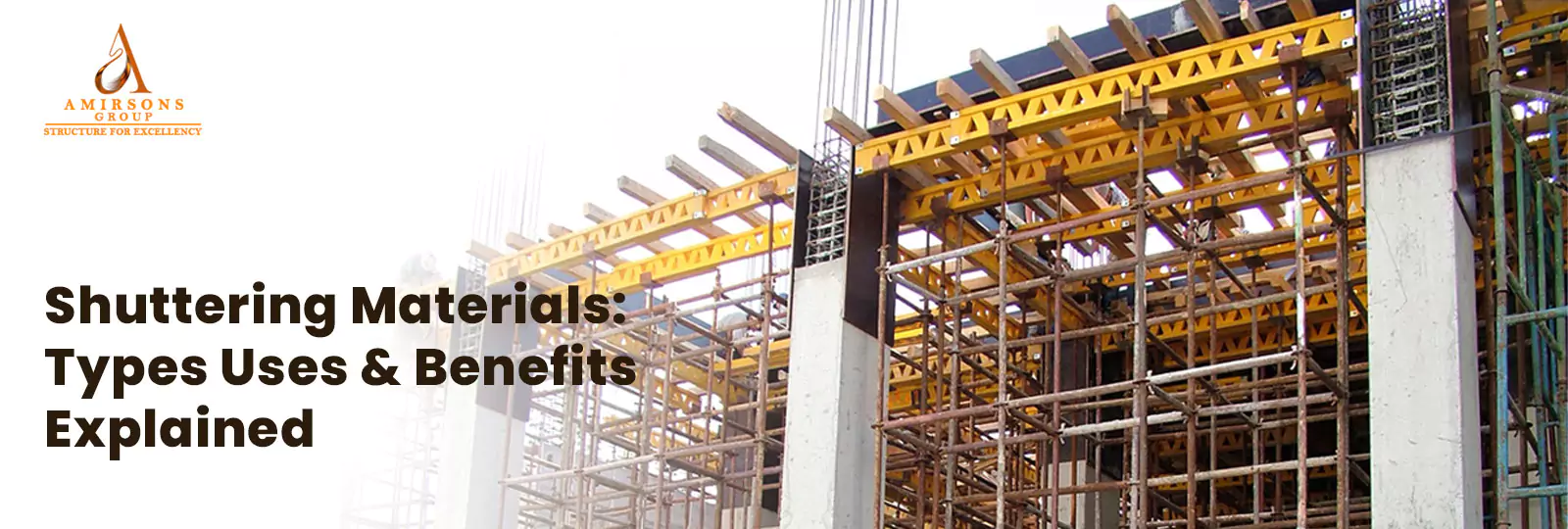In construction projects, shuttering or formwork is crucial. It properly supports wet concrete before it sets into the desired shape. Shuttering is critical for the strength and accuracy of concrete structures, whether residential buildings or elaborate commercial activities.
Shuttering materials are fundamental in ensuring that the structural works or concrete framework of a residential house, a commercial skyscraper, or a bridge remains stable throughout the construction process and for many years to follow.
What is Shuttering in Construction?
Shuttering refers to the temporary moulds or structures used to contain and shape wet concrete during the curing process. These moulds provide stability to the structure and help achieve the desired design and strength.
Whether you are constructing a residential property, a commercial high-rise, or a bridge, shuttering materials ensure that your concrete structures are well-supported during construction and remain robust for years to come.
Types of Shuttering Materials
Timber Shuttering
Timber shuttering frames are among the oldest types of formwork and are most commonly used. They are easy to work with, light, and can be constructed into different shapes and styles. However, their low durability means they are only suitable for small buildings like houses.
Plywood Shuttering
The plywood formwork shutters are produced from composite wood giving it a smooth finish and can be reused multiple times. Because of these qualities, it is a popular option for the walls, slabs, and columns of homes and business buildings.
Steel Shuttering
It is possible to exploit steel shuttering, as it is moisture-resistant and extremely durable. Therefore, a steel form, once built, can be used for a wide variety of applications such as the unnecessary formwork of bridges, bridges, skyscrapers, dams, etc. Despite having initial high costs, it becomes economical after years of usage due to its strength and reusability characteristics.
Aluminum Shuttering
Aluminium shuttering is highly utilized for concentrically marked structures and precast concrete constructions due to its incredibly lightweight and rust-resistant nature. Furthermore, it is simple to move and put together and thus is a worthwhile time economy measure.
Plastic Shuttering
Plastic formwork is a more advanced option and is also appreciated for its strength and ability to be used for architectural designs that are more intricate. It is also fairly easy on the environment - light and highly suited for decorative concrete works.
FRP Shuttering
FRP Shuttering is becoming increasingly popular due to its high strength and chemical resistance. It is ideal for complex design work and is a sustainable option for construction.
Uses of Shuttering Materials in Construction
a. Creating Durable Structures
Shuttering maintains the form and preserves the strength of the concrete throughout the curing process, resulting in durable buildings.
b. Supporting Architectural Designs
It allows construction teams to execute complex architectural designs, from curved walls to decorative columns.
c. Managing Heavy Loads
Materials like steel provide excellent support for heavy concrete loads in large-scale projects.
d. Enabling Quick Construction
Lightweight options such as plastic and aluminium shuttering reduce construction time and labour costs.
Benefits of Choosing the Right Shuttering Material
a. Durability
High-quality materials like steel and FRP provide long-term durability for concrete structures.
b. Cost-Effectiveness
Reusable materials such as aluminium and plywood reduce overall construction costs, especially for multiple projects.
c. Enhanced Finish Quality
Smooth shuttering surfaces like plywood or FRP result in superior concrete finishes.
d. Eco-Friendly Solutions
Modern materials like plastic and FRP are recyclable and contribute to sustainable construction practices.
e. Adaptability
There is shuttering material available for every project as there are options from timber to aluminum.
How to Choose the Right Shuttering Material?
- Project Scale: Match the material to your project's size and complexity.
- Budget: Opt for cost-effective and reusable materials if you're on a tight budget.
- Environment: Use moisture-resistant materials for wet or humid conditions.
- Reusability: For frequent projects, choose durable options like steel or aluminium.
Additionally, for construction teams looking to save costs, shuttering material on hire is an excellent option. It allows you to access high-quality materials without the burden of purchasing them outright.
Conclusion
Shuttering materials are a very important element in every building project. The type of material chosen is paramount to the efficiency, longevity, and costs of the project. Be it timber for small houses or steel for bigger works, knowing the various types, uses, and advantages of these materials is crucial.
For those in need of affordable and high-quality options, services like scaffolding rental in Noida make it easy to access the best equipment for your needs.
At Amrison, always prioritize quality, affordability, and sustainability. Let us help you build your dream project with ease and confidence. Contact us today for expert guidance!



Enquire Now